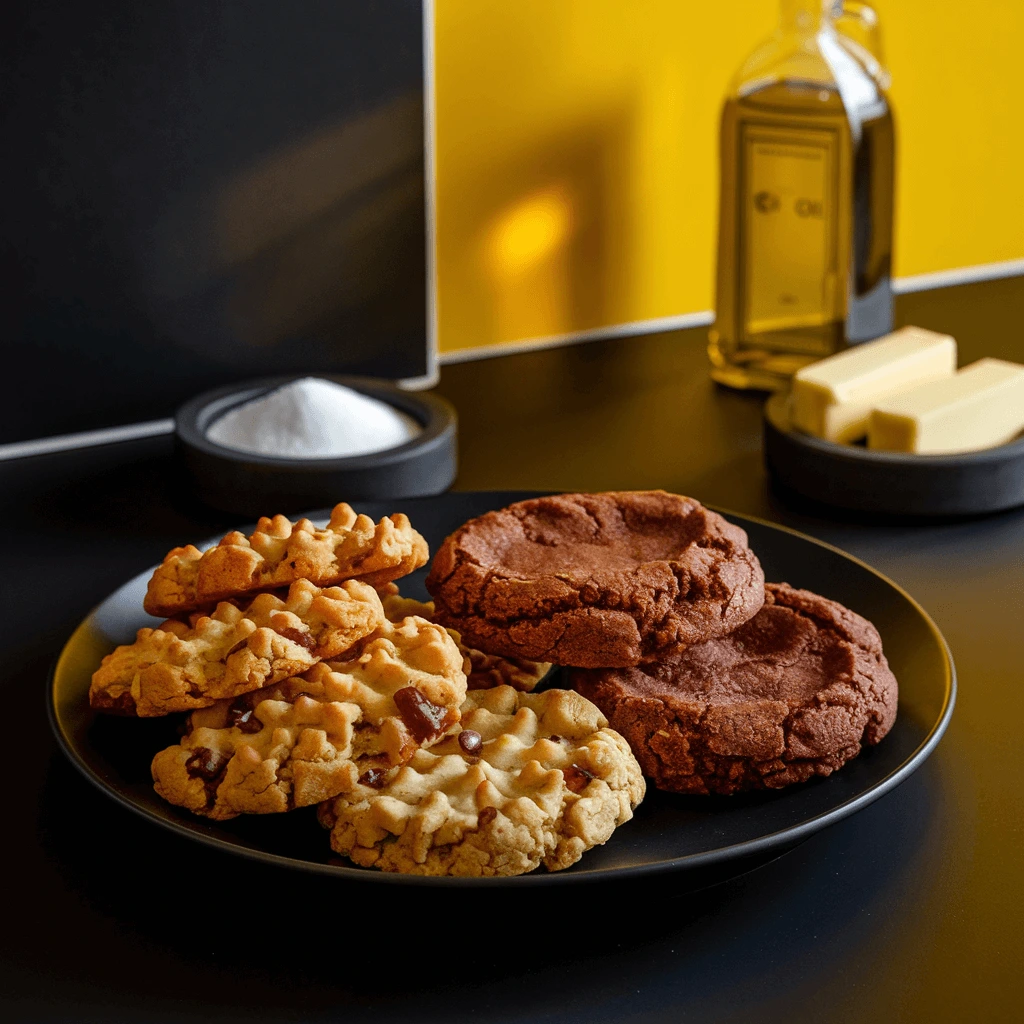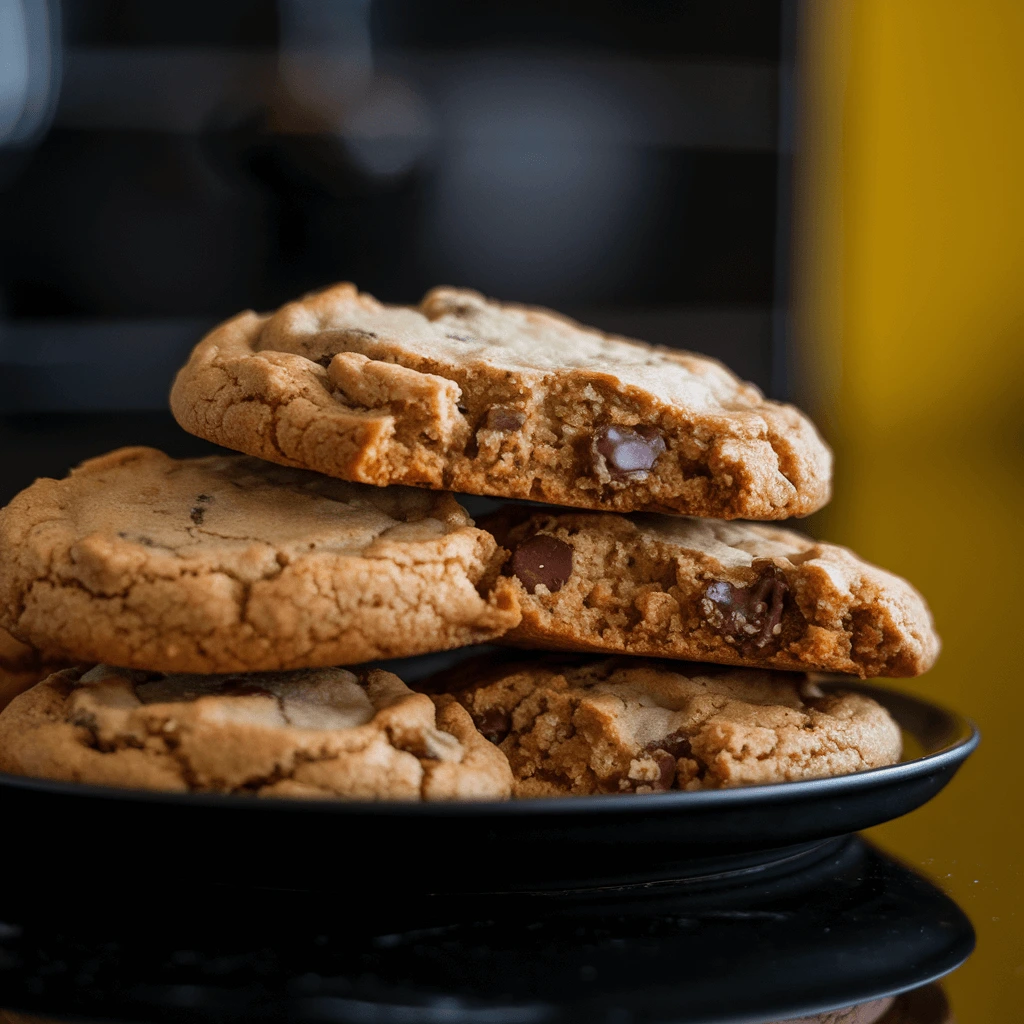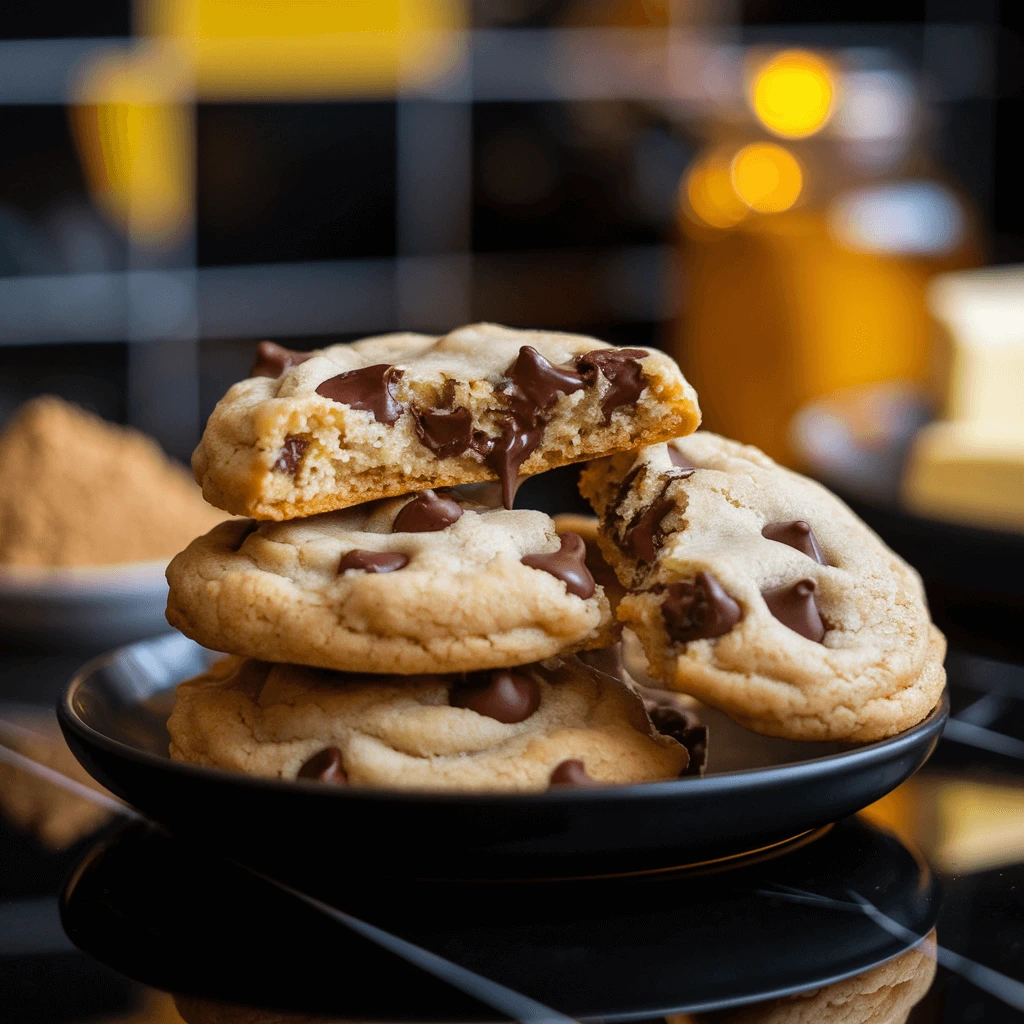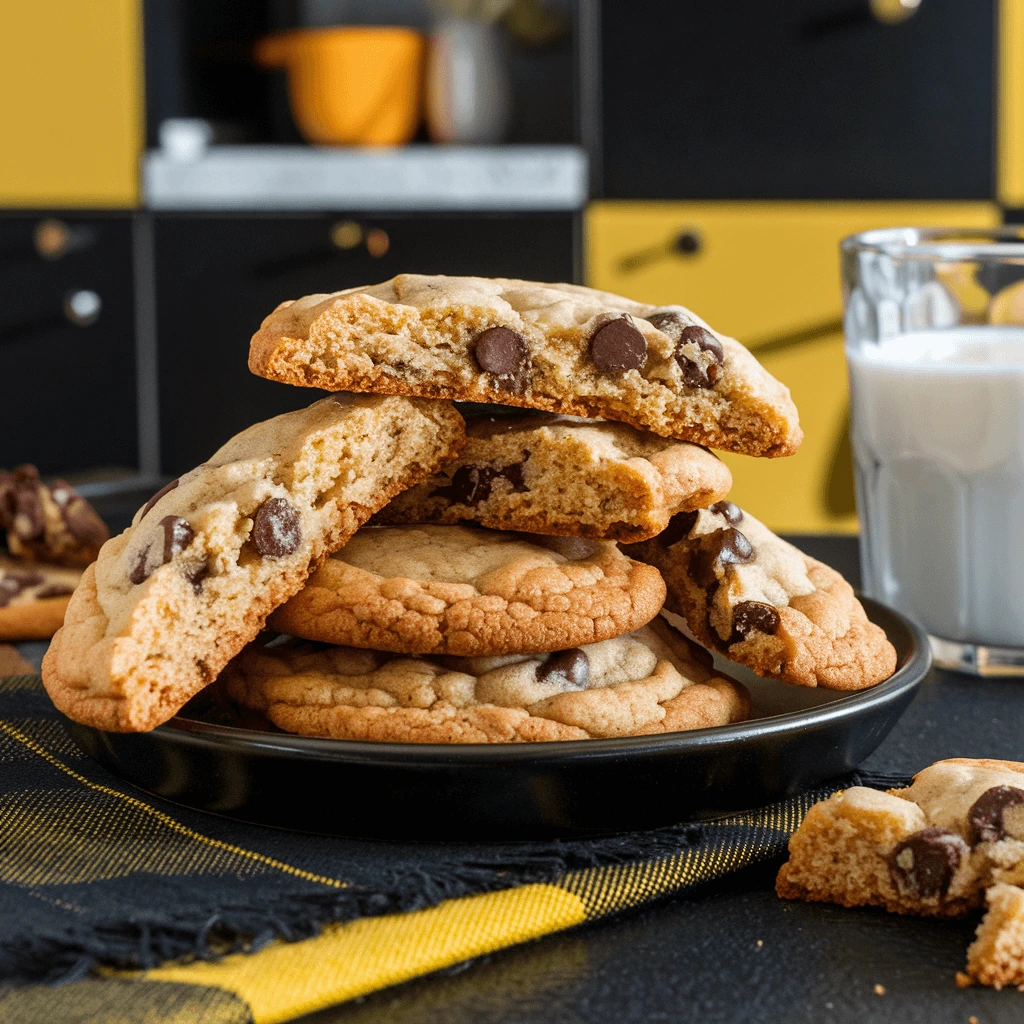There’s something undeniably satisfying about biting into crunchy chip cookies—that perfect snap, the golden edges, and the delightful contrast of crispness with melty chocolate chips. While some cookie lovers prefer the soft and chewy variety, there’s a special charm to cookies that deliver a satisfying crunch in every bite.
But what makes crunchy chip cookies different from their chewy counterparts? Is it the baking time, the sugar ratio, or a secret ingredient that gives them their signature crisp texture? Whether you love crispy chocolate chip cookies for dunking in milk or simply enjoy the classic buttery crunch, mastering the right techniques is key to getting bakery-style results at home.
After exploring the beloved classic flavors in our Mini Pancakes Recipe: Quick, Easy, and Delicious, let’s dive into this simple yet delicious recipe that’s sure to become a favorite in your kitchen! In this guide, we’ll uncover the science behind cookie texture, explore the best ingredients and baking methods for perfectly crunchy chip cookies, and share expert tips on how to keep them crisp for days. If you’ve ever wondered how to achieve the ultimate crunchy chip cookie, keep reading—you’re about to discover the secrets to baking perfection.
Table of Contents
What Makes Cookies Crunchy or Chewy? The Science Behind Texture
When it comes to baking cookies, the difference between crunchy chip cookies and chewy cookies isn’t just about preference—it’s about science. The ingredients you use and the baking techniques you apply all play a crucial role in determining whether your cookies turn out crispy, crunchy, or soft and chewy.
The Role of Sugar: White Sugar vs. Brown Sugar
The type of sugar used plays a key role in shaping the texture of cookies. Sugar doesn’t just add sweetness; it affects moisture retention, spread, and caramelization, which all contribute to either a crunchy or chewy cookie.
- White Sugar = Crispier Cookies
White sugar (granulated sugar) contains no molasses, which means it doesn’t retain moisture. Instead, it helps cookies spread more in the oven and encourages caramelization, leading to thin, crunchy chip cookies. When cookies spread thin, they dry out faster, creating that signature snap with a delicate crisp texture. - Brown Sugar = Chewy Cookies
Brown sugar contains molasses, which holds onto moisture. This keeps cookies thicker, softer, and chewier by slowing down evaporation during baking. The molasses also adds a richer, deeper flavor and creates a slight stickiness in the final texture. - Balancing the Two for the Perfect Texture
The key to customizing your cookie texture is adjusting the ratio of white to brown sugar. If you want crunchy chip cookies, increase the white sugar and reduce the brown sugar. If you prefer chewy cookies, do the opposite.
Butter, Oil, or Shortening: Which One Makes Cookies Crunchy?
The type of fat used in cookie dough significantly influences the final texture and structure of the cookies.
- Butter for Crispy, Crunchy Chip Cookies
Butter is 80% fat and 20% water, and when it melts, the water evaporates, leaving a drier dough behind. This evaporation helps create thin, crisp edges and a brittle, crunchy texture. Using melted butter in the dough allows cookies to spread more, making them even crispier. - Shortening for Thicker but Still Crunchy Cookies
Shortening is 100% fat with no water content, meaning it prevents excessive spread. Cookies made with shortening tend to be thicker but still crunchy, as there is no steam evaporation to create a softer texture. - Oil for Soft and Chewy Cookies
Cookies made with vegetable oil tend to be softer and denser since oil is liquid at room temperature. This means the dough doesn’t solidify as butter does, preventing the crisp edges found in crunchy chip cookies.
💡 Pro Tip: If you want extra crispy cookies, use melted butter and a bit less egg yolk, as yolks add richness but also moisture.
Baking Soda vs. Baking Powder: Which One Affects Crunchiness?
Leavening agents like baking soda and baking powder don’t just make cookies rise; they also impact the texture and spread of the dough.
- Baking Soda for Crispier, Crunchier Cookies
Baking soda (sodium bicarbonate) is a strong alkaline that spreads the cookie dough by breaking down acids in the ingredients. This reaction enhances browning and caramelization, leading to crisper edges and a more pronounced crunch. Crunchy chip cookies often rely on baking soda to help the dough spread and develop that golden, brittle texture. - Baking Powder for Softer, Puffier Cookies
Baking powder contains both an acid and a base, which means it produces a gentler rise in baked goods. Instead of spreading outward, cookies made with baking powder rise upward, creating a softer, cake-like texture rather than a crunchy one.
💡 Pro Tip: If you want extra crunch, use baking soda instead of baking powder, and bake the cookies at a slightly lower temperature (325°F-350°F) for a longer time. This dries out excess moisture without burning the edges.

How to Make the Perfect Crunchy Chip Cookies
Achieving the perfect crunchy chip cookies requires more than just throwing ingredients together. The secret lies in choosing the right ingredients, mastering baking techniques, and storing them properly to maintain their crispness. If you want cookies with a buttery snap and a satisfying crunch, follow these expert tips and tricks.
Choosing the Right Ingredients for Extra Crisp
The foundation of crunchy chip cookies starts with the right ingredient ratios. By adjusting sugar, fat, and moisture content, you can create cookies that have the ideal golden-brown crispness without being dry or brittle.
1. Use More White Sugar Than Brown Sugar
- White sugar caramelizes and creates a crisp texture as it melts and hardens in the oven.
- Brown sugar contains molasses, which retains moisture, making cookies softer and chewier.
- For crunchy chip cookies, use a higher ratio of white sugar to brown sugar (e.g., ¾ cup white sugar and ¼ cup brown sugar).
2. Melted Butter for Extra Crispiness
- Melted butter adds richness and spreads the dough thinner, helping create a crunchy cookie with crisp edges.
- If you use softened or cold butter, your cookies will be thicker and less crispy.
- Using a higher fat-to-liquid ratio (more butter, less egg) enhances the snap.
3. Reduce Egg Yolks to Minimize Moisture
- Eggs provide structure and moisture to cookies.
- For crunchy chip cookies, use one whole egg and skip the extra yolk to reduce moisture and prevent chewiness.
- You can also replace an egg with a tablespoon of milk or water to maintain binding without adding extra softness.
4. Add Cornstarch for Texture Control
- A teaspoon of cornstarch helps create a light, crisp texture without making the cookies too dense.
- It prevents over-spreading while allowing a delicate, crunchy bite.
💡 Pro Tip: If you want extra crispy cookies, substitute 1-2 tablespoons of flour with cornstarch to maintain structure while keeping them crunchy.
The Secret Baking Techniques for a Perfect Crunch
Baking temperature and time directly affect the texture of cookies. If you want crispy, crunchy chip cookies, focus on these techniques:
1. Spread the Dough Thin for an Evenly Crispy Cookie
- Thinner dough leads to crunchier cookies because it bakes more evenly and dehydrates faster.
- Use a cookie scoop and press down slightly before baking to ensure even thickness.
- If the dough is too thick, the centers may stay soft instead of becoming crisp.
2. Bake at a Lower Temperature for a Longer Time
- A lower baking temperature (325°F-350°F) allows cookies to bake slowly and evenly, removing excess moisture for a crunchier result.
- High temperatures (375°F or above) cook cookies too quickly, leading to soft centers and less crisp edges.
- Bake for 14-16 minutes at 325°F instead of the usual 10-12 minutes at 350°F.
3. Use the Right Baking Surface
- Line your baking sheet with parchment paper instead of greasing it. Buttered baking sheets cause cookies to spread too much, making them too thin.
- Use a light-colored baking sheet, as dark sheets absorb more heat and may over-brown the bottoms.
💡 Pro Tip: Flip the baking sheet halfway through baking to ensure even heat distribution.
Cooling and Storing Tips to Maintain Crunch
Even the crispiest cookies can turn soft if not stored properly. Follow these cooling and storage methods to keep your crunchy chip cookies crisp for days.
1. Let Cookies Cool Completely on a Wire Rack
- After baking, transfer cookies to a cooling rack to allow air circulation around all sides.
- If cookies are left on the baking sheet, they may continue to bake from residual heat, making them too dry instead of crunchy.
2. Store in an Airtight Container
- Moisture is the enemy of crunchy cookies. Store them in an airtight container to prevent humidity from softening them.
- If you live in a humid climate, add a small packet of silica gel or a slice of bread wrapped in a paper towel to absorb excess moisture.
3. Keep Cookies at Room Temperature
- Never refrigerate cookies—the cold air makes them stale and changes their texture.
- Store them in a cool, dry place at room temperature for up to a week.
4. Re-Crisp Soft Cookies in the Oven
- If cookies lose their crunch, reheat them in a 300°F oven for 5-7 minutes to remove excess moisture.
- Allow them to cool again before storing.
💡 Pro Tip: Always store cookies separately from soft baked goods—otherwise, moisture from other baked items (like brownies or cake) can make your crunchy cookies soft.

How to Make Soft and Chewy Cookies Instead
While crunchy chip cookies are loved for their crisp snap, some cookie lovers prefer the gooey, chewy bite of soft cookies. Achieving the perfect soft and chewy texture requires different techniques, from adjusting ingredients to tweaking baking methods. If you love thick, chewy cookies with a tender center, follow these expert tips.
Why More Moisture Creates a Chewy Texture
The secret to soft and chewy cookies is moisture retention. Unlike crunchy chip cookies, which are designed to dry out for crispness, chewy cookies maintain moisture throughout baking. Here’s how to get that soft, bendable bite.
1. Use More Brown Sugar Than White Sugar
- Brown sugar contains molasses, which helps cookies retain moisture and stay soft longer.
- More brown sugar = chewier cookies, while more white sugar = crispier cookies.
- If you want ultra-chewy cookies, use at least ⅔ brown sugar and ⅓ white sugar in your recipe.
2. Add Extra Eggs or Egg Yolks
- Eggs provide structure and moisture, which helps create thicker, chewier cookies.
- Adding an extra egg yolk (instead of a whole egg) increases richness while keeping cookies soft.
- If you want extra chewiness, try using one whole egg + an extra yolk instead of two whole eggs.
3. Add Honey or Corn Syrup for Maximum Chew
- Liquid sweeteners like honey, maple syrup, or corn syrup help trap moisture, preventing cookies from drying out.
- Just one tablespoon of honey or corn syrup can make a noticeable difference in chewiness.
4. Bake at a Higher Temperature for a Quick Set
- Unlike crunchy chip cookies, which bake low and slow, chewy cookies need a high temperature.
- Bake at 375°F (190°C) for 8-10 minutes to quickly set the edges while keeping the center soft and chewy.
- Avoid overbaking—chewy cookies should look slightly underdone in the middle when removed from the oven.
💡 Pro Tip: If you want chewy cookies with crisp edges, bake at a slightly lower temperature (350°F) and pull them out just as they turn golden brown.
Mixing and Resting the Dough for a Soft Bite
Even the way you mix and rest your dough can dramatically impact chewiness. Here’s how to make your cookies soft and tender every time.
1. Chill the Dough Before Baking
- Chilling cookie dough helps hydrate the flour, giving cookies a softer, more tender texture.
- It also prevents cookies from spreading too much, keeping them thicker and chewier.
- For best results, chill your dough for at least 30 minutes (or up to 24 hours) before baking.
2. Avoid Overmixing the Flour
- Overmixing develops too much gluten, which leads to tough, dense cookies instead of soft and chewy ones.
- Mix the flour just until combined—once you no longer see dry flour, stop mixing.
- For extra chewy cookies, use bread flour instead of all-purpose flour, as it has a higher protein content, creating a more toothsome bite.
💡 Pro Tip: If you accidentally overmix, let the dough rest for 20 minutes before baking to allow the gluten to relax.
Storage Tips to Keep Cookies Chewy Longer
The right storage techniques can preserve chewiness for days, preventing cookies from turning dry or stale.
1. Use a Slice of Bread in the Container
- Placing a slice of fresh bread inside the cookie container prevents cookies from drying out.
- Placing the cookies with a slice of bread helps them absorb moisture, keeping them soft and chewy.
- Use white bread, as it won’t transfer flavors to the cookies.
2. Store in an Airtight Container
- Chewy cookies lose moisture faster when exposed to air.
- Keep them in an airtight container at room temperature to lock in moisture.
- Separate soft cookies from crunchy ones—storing them together can make crunchy cookies go soft and soft cookies go stale.
3. Avoid Refrigeration—It Dries Cookies Out
- Never store cookies in the fridge—cold air removes moisture, making them dry and hard.
- If you need to store them for a longer period, freeze them instead.
4. Reheat Cookies for Instant Softness
- If cookies harden over time, microwave them for 5-10 seconds to restore chewiness.
- Alternatively, warm them in a 300°F oven for 5 minutes for a fresh-baked feel.
💡 Pro Tip: If freezing cookies, wrap them individually in plastic wrap and place them in an airtight bag. Defrost at room temperature or microwave for a few seconds before serving.

Crunchy vs. Chewy Chip Cookies – Which One Wins?
When it comes to cookies, there’s always one big debate—do you prefer crunchy chip cookies or soft and chewy ones? Some cookie lovers crave the golden, crisp edges and satisfying snap of a crunchy cookie, while others can’t resist the thick, gooey, and chewy bite of a soft cookie.
But which cookie texture is truly the best? The answer depends on personal preference, occasions, and even how you plan to enjoy your cookies. Let’s break down the key differences between crunchy and chewy chip cookies, explore when each type shines, and help you decide which one wins in your kitchen.
Best Occasions for Each Type of Cookie
Cookies aren’t just a treat—they’re a comfort food enjoyed in many different ways. Some moments call for a delightfully crispy cookie, while others demand a soft, melt-in-your-mouth bite.
Crunchy Cookies: Perfect for Dunking and Gifting
Crunchy chip cookies are perfect for those who love texture and a deep caramelized flavor. Their thin, crisp bite makes them ideal for certain occasions:
✔ Dunking in Milk or Coffee – The crisp edges hold up well when dipped, soaking up just the right amount of liquid without falling apart.
✔ Holiday Cookie Gifts – Crunchy cookies store better and stay fresher longer, making them ideal for homemade gift boxes.
✔ Snacking on the Go – Because they’re less delicate than chewy cookies, they hold up better when packed in lunchboxes or road trip snacks.
💡 Best crunchy cookies: Biscotti, shortbread, and thin chocolate chip cookies.
Chewy Cookies: The Ultimate Comfort Treat
Chewy cookies are all about softness, richness, and indulgence. If you love a thick, soft center, chewy cookies are perfect for:
✔ Soft Dessert Lovers – If you enjoy fudgy brownies or gooey pastries, chewy cookies will hit the spot.
✔ Ice Cream Sandwiches – Their soft texture makes them easy to bite into when paired with frozen treats.
✔ Warm and Fresh Enjoyment – Nothing beats a chewy cookie straight from the oven, with melty chocolate chips and a warm, soft center.
💡 Best chewy cookies: Classic chocolate chip, oatmeal raisin, and molasses cookies.
Which Cookie Texture Do People Prefer?
While both textures have their fans, chewy cookies tend to be the crowd favorite. In various consumer preference polls, a majority of people lean toward soft and chewy cookies, but there’s still a loyal following for the crisp, crunchy variety.
Why Some Love Crunchy Cookies
For some, texture is everything. A cookie with crisp edges and a delicate snap gives a buttery, slightly caramelized bite that’s completely satisfying. The slightly dry texture makes crunchy chip cookies a great pairing with coffee, tea, or milk.
✔ People who enjoy crispy treats like biscotti, wafers, or shortbread tend to prefer crunchy cookies.
✔ Some believe crunchy cookies feel more “traditional,” reminiscent of classic store-bought cookies.
Why Others Prefer Chewy Cookies
On the other hand, chewy cookies deliver a soft, fudgy bite with gooey chocolate and a rich flavor. Many cookie lovers crave the soft, tender texture that makes cookies feel more indulgent.
✔ Soft cookies remind people of freshly baked, homemade treats with a comforting, warm texture.
✔ Chewy cookies feel more substantial and satisfying, especially when filled with chocolate chips or nuts.
✔ Some people prefer the slight “stretch” and moisture of a chewy cookie over the brittle snap of a crunchy one.
💡 Poll Data (General Trends):
- 60-70% of respondents in cookie preference polls typically choose chewy cookies over crunchy ones.
- 30-40% prefer crunchy cookies, especially for snacking, dunking, and gifting.
Ultimately, cookie texture is a personal preference, and both styles have their loyal fans!
Final Thoughts: The Secret to Achieving Your Perfect Cookie
So, crunchy or chewy—who wins? The truth is, it’s all about what YOU love. The beauty of baking is that you can tweak recipes to achieve your ultimate cookie texture.
How to Adjust Cookie Texture to Your Preference
If you want crunchy chip cookies:
✔ Use more white sugar than brown sugar for caramelization and crispness.
✔ Use melted butter and spread the dough thinner before baking.
✔ Bake at 325°F-350°F for a longer time to remove moisture slowly.
If you want soft and chewy cookies:
✔ Use more brown sugar and an extra egg yolk to retain moisture.
✔ Add a tablespoon of honey or corn syrup to increase chewiness.
✔ Bake at 375°F for a shorter time to set the edges while keeping the center soft.
Experiment and Find Your Favorite!
There’s no right or wrong when it comes to cookies—the best cookie is the one you love the most. Whether you enjoy the satisfying crunch of a crispy cookie or the warm, gooey bite of a chewy one, baking gives you the freedom to experiment and create the perfect texture for you.
Next time you bake a batch, try testing both textures—make one sheet crunchy and another chewy. You might find that you love both equally!
💡 Final Tip: The magic of cookies is that a single base recipe can be customized to create either texture. So why not bake half a batch crunchy and half a batch chewy—then have a taste test to see which one wins in your home?
Love baking cookies? Discover even more expert tips and mouthwatering recipes in The Perfect Cookie—available now on Amazon!
